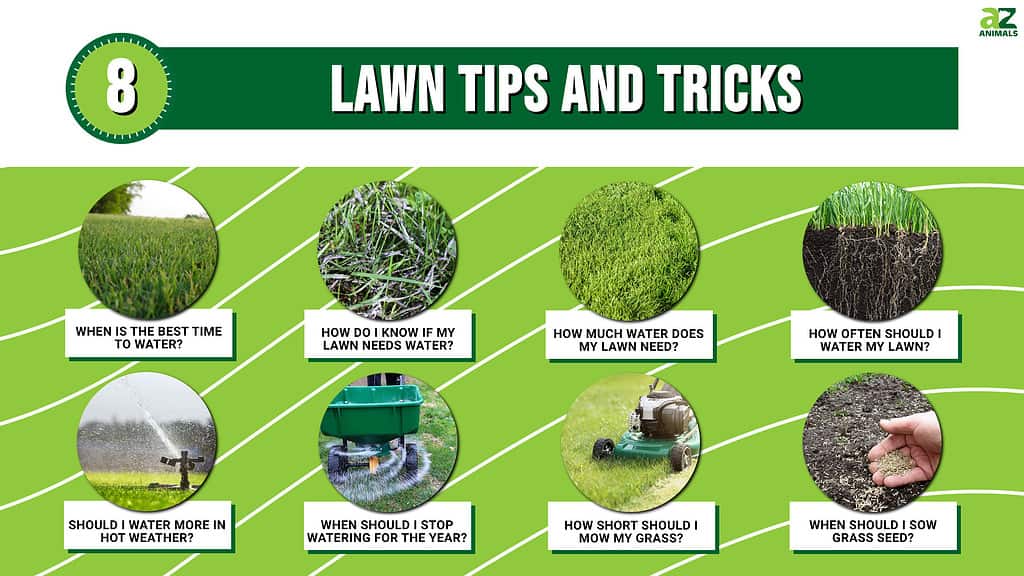
Everyone wants a lush green lawn. It increases the curb appeal and property value of your home. Your friends and family will enjoy the beautiful outdoor space created by your healthy yard. And if it makes the neighbors a little jealous, that’s just a bonus, right? Keeping your grass green and healthy from spring to fall requires consistent water, but when is the best time to water your lawn? We have the answer for you, along with some other tips and best practices.
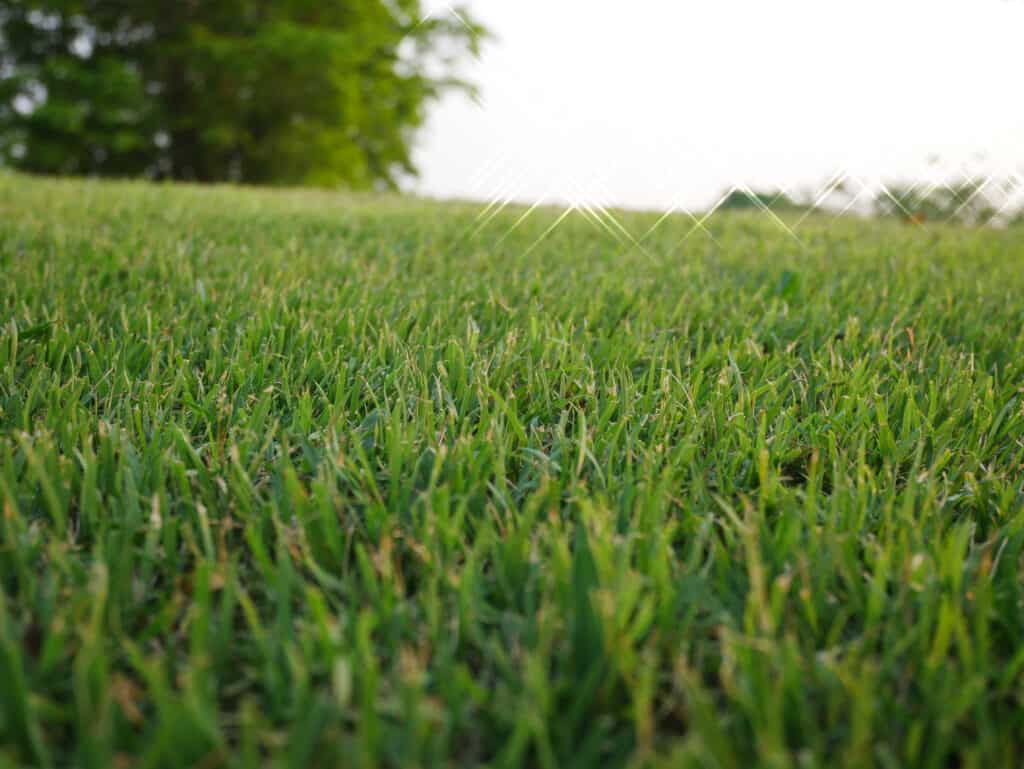
Everyone wants a lawn to make their neighbors “green” with envy!
©Joyjiraporn/Shutterstock.com
1. When Is the Best Time to Water?
The best time to water your lawn is between 6 a.m. and 10 a.m.
Watering in the morning gives the moisture plenty of time to soak into the soil where the grassroots can absorb it. If you water later in the day when the sun is high, much of the water may evaporate before it can penetrate the soil.
To avoid evaporation, some people choose to water in the evening. This can lead to problems, though. Nighttime watering significantly increases the chances of turf disease. Fungal diseases require three things to infect your lawn, as seen in the illustration below.
- The susceptible host is grass, which is susceptible to disease.
- The pathogen is the organism that causes the disease.
- The conducive environment is the condition needed for the pathogen to grow.
These three requisites are known as the disease triangle. When all three are present, disease can result. If any one of the three requirements is absent, the plant disease cannot take hold.

The plant disease triangle lists the three components needed for a fungal disease to take hold.
©Johannes Rössel / CC BY-SA 3.0 – License
The easiest one of the three for homeowners to control is the conducive environment. Common lawn diseases require a lot of moisture. By watering at night, moisture is added to your lawn without the evaporative effect of the sun. This can create the conducive environment needed for a fungal disease to take hold.
If watering in the morning simply is not an option, you can water your lawn between 4 p.m. and 6 p.m. The sun is not directly overhead, so the water won’t evaporate too quickly. Conversely, your yard will have a little time to dry out before nightfall.
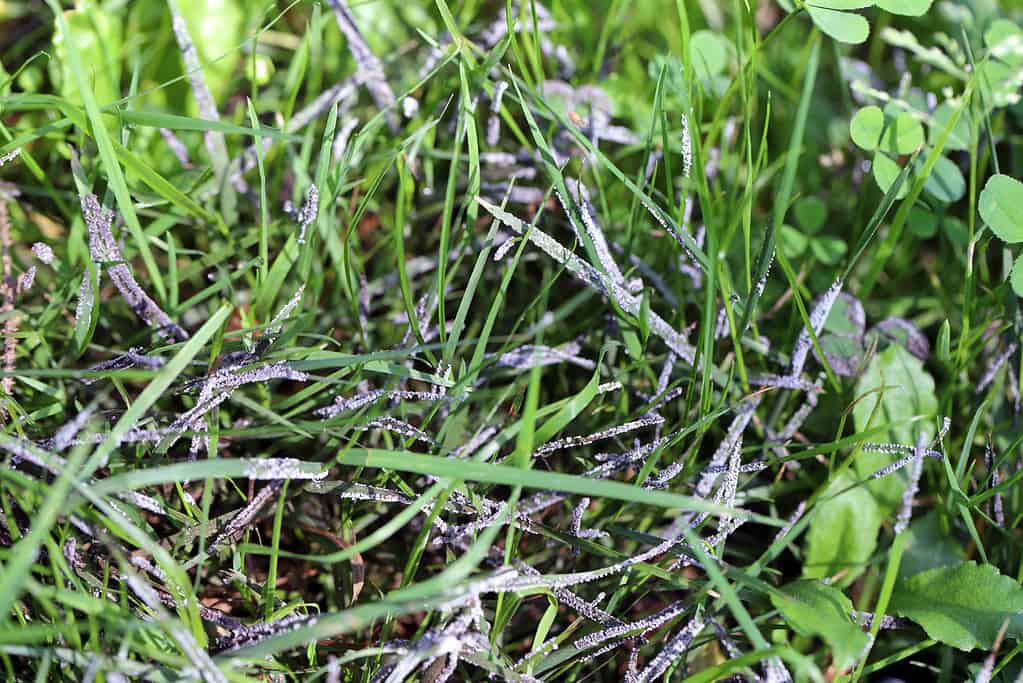
Fungal disease can only infect grass if all three components of the “disease triangle” exist.
©iStock.com/Tomasz Klejdysz
2. How Do I Know If My Lawn Needs Water?
No one wants to water their lawn if the grass doesn’t need it. It is wasteful and can even be harmful to your yard. So how do you know if your lawn actually needs to be watered?
If your grass is discolored, taking on a dull green or even a gray appearance, that is a sign that your lawn needs a drink. Also, take a look at the individual blades of grass. Curved blades likely mean the grass is underwatered.
You can also use the tried-and-true screwdriver test. If you can’t easily push a screwdriver six inches into the ground, it is probably time to water.
Finally, you can just take a walk through your yard. If your footprints don’t disappear quickly, that is a sign that your grass doesn’t have enough moisture to spring back.
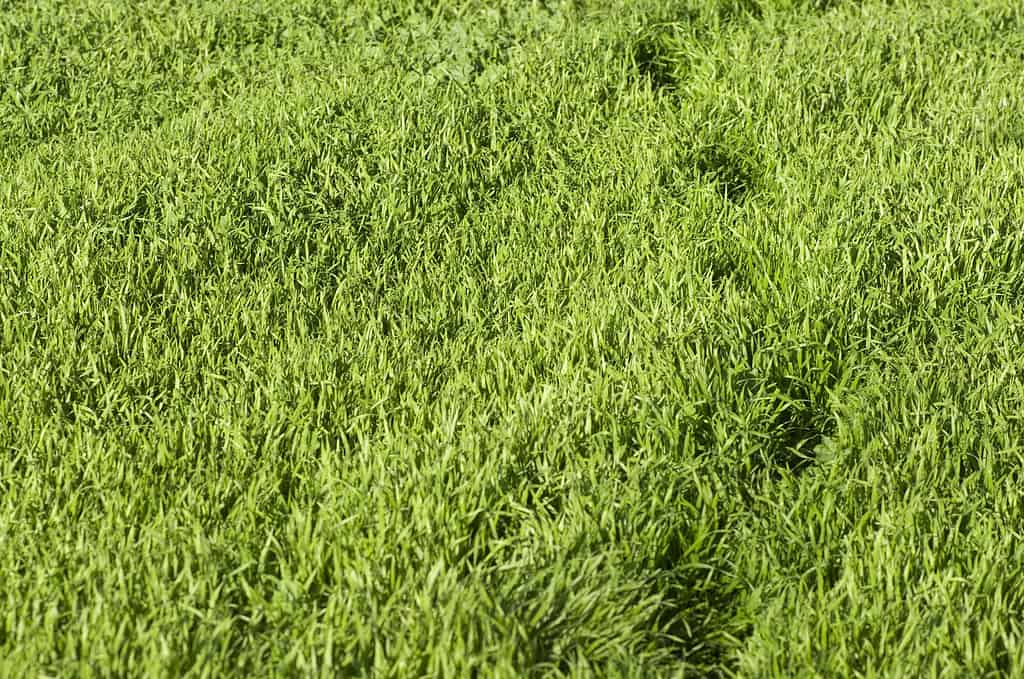
Walk through your yard and see how long your footprints take to disappear.
©iStock.com/
3. How Much Water Does My Lawn Need?
Even if property owners know when to water, they still may not be sure about how much water they should provide for their lawns. Generally speaking, grass needs 1-1.5 inches of water each week for optimum health, color, and growth.
However, you don’t necessarily want to provide a week’s worth of moisture in one watering session. The soil can only absorb so much moisture at one time. The rest will be lost to runoff. It is best to divide the week’s worth of water into two watering sessions separated by several days.
Some more expensive sprinkler systems have flow monitors so you can see exactly how much water you have added to your yard. But there is a trick you can use if you don’t have one of these monitors.

Too much water at one time will run off and not reach the grassroots.
©iStock.com/
You can set up empty cans within the range of your sprinkler (tuna or cat food cans work well). Turn on your sprinkler and then time how long it takes for half to three-quarters of an inch of water to collect in the cans. That can give you a good gauge of watering duration for the remainder of the growing season. If you water that long twice a week, you’ll provide your lawn with weekly water needs.
It is important not to overwater your lawn. In the video below, the experts from Green Meadow Lawn Care in Connecticut discuss the disease triangle further, noting that overwatering is one of the most common causes of lawn disease.
4. How Often Should I Water My Lawn?
It may seem better to use shorter watering sessions every day, but it is not. Grass roots will grow toward moisture. If you provide just a little water every day, the water will not penetrate deep enough into the soil. This will cause grass roots to turn upward toward the source of moisture. Healthy plants, including grass, need deep roots to thrive. Instead of short watering bursts every day, a couple of deep waterings each week will promote deeper, stronger root growth.
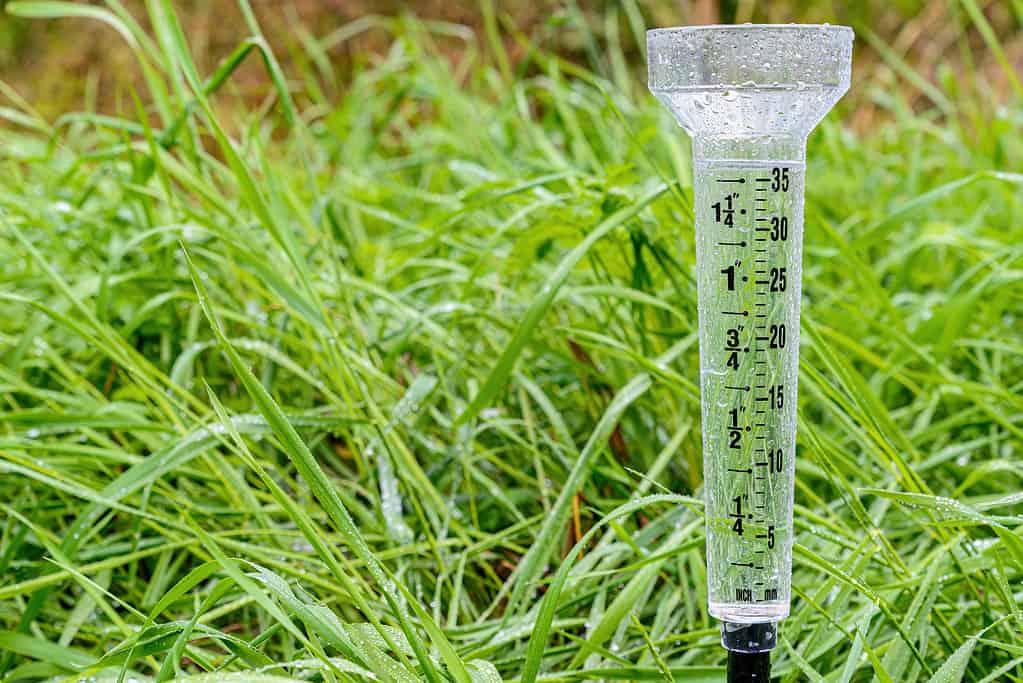
Adjust your watering frequency based on how much rain your lawn receives.
©iStock.com/
This is all contingent on the weather, though. There will be many weeks when you can dial back on the watering or just skip it altogether. Rain is always the best way to water your lawn. It provides deep, even watering that no sprinkler system can match. Oh, and it’s also free!
It can be difficult to guesstimate how much water your lawn actually receives in a rainstorm, though. A rain gauge can eliminate the guesswork. It’s also important to remember that the soil may not absorb all the water from an especially heavy downpour. If your lawn is hit with a deluge, at least some of that water will run off. Go back to the tips discussed above when deciding whether your lawn needs additional watering.
5. Should I Water More in Hot Weather?
The dog days of summer are hot and often dry, so your lawn will likely need some additional water. You can add one more day to your weekly watering schedule during a heat wave, but it is still possible to overwater your lawn. While it may be tempting to really pour it on, so to speak, restraint is important even in exceptionally hot weather.

You’ll likely need to water more during the summer months.
©iStock.com/
When the temperature is 85°F or above, you can hit your lawn with a quick burst of water in the middle of the day. The goal isn’t to soak into the soil like a regular watering session, though. Rather, the purpose is to cool off the grass. Heat stress can send grass into dormancy. In dormancy, the lawn can appear brown and dry. Quick hits with water on very hot days can relieve the heat stress and keep your grass out of this unsightly dormant state. As discussed earlier, these watering sessions are very short, so they won’t turn the roots upward. Most of the water in these five-minute waterings won’t even penetrate the soil. In this case, it’s not about hydrating the grass but rather cooling it off.
6. When Should I Stop Watering for the Year?
Many homeowners stop watering too early each year. Fall is an essential season for your lawn. The autumn season is when your lawn rebuilds from the summer heat and prepares for winter dormancy. This is certainly not the time to withhold water!
Grass keeps growing throughout the fall. The growth may not be as apparent above ground, but critical growth is happening underground. Keep watering your lawn until the ground freezes. It’s okay if the neighbors find it odd. They’ll change their tune when they see your lawn the following spring!
Not only is water essential during the fall, but it is also the best time to feed your lawn. Most homeowners think about fertilizing their yards in the spring. You can hit your lawn with a light feeding in the spring, but the fall is a much better time for deep fertilization. When a lawn is well-fed and well-watered in the fall, that lawn will look amazing in the spring.
Also, a bit of free advice: make sure to remove your hose from the spigot when the temperatures drop below freezing. Otherwise, water can remain lodged in the pipe by the spigot. If that water freezes, the spigot can burst.

Fall is the most crucial season for your lawn. Water and feed it well!
©iStock.com/
7. How Short Should I Mow My Grass?
It is tempting to lower the deck on your mower to cut your grass short. Some believe their lawns look better when they are mowed short. Also, if you cut the grass shorter, you will have to mow less often, which certainly sounds appealing. However, mowing your grass too short can harm your lawn. If you’ve invested time and resources into your lawn to keep it looking its best, you don’t want to undermine it all with your lawnmower.
As a general rule, you should never cut more than one-third of a grass blade when you mow. Cutting more than the top one-third of the blade can stress the grass and lead to brown spots.
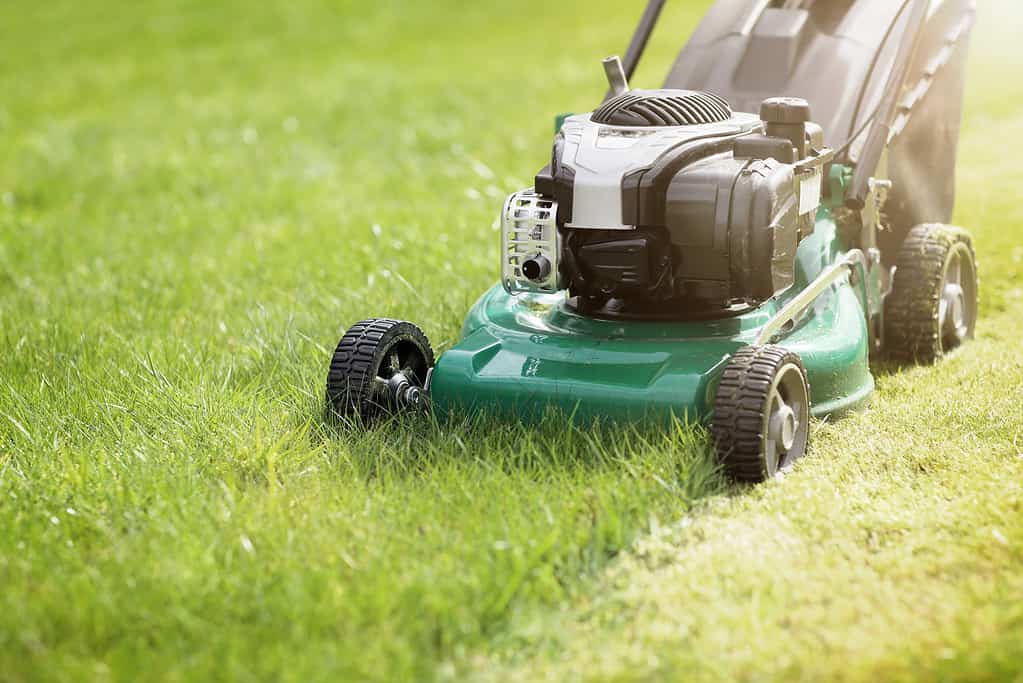
Many people mow their grass too short. Never cut more than one-third of the grass blades.
©iStock.com/BrianAJackson
Also, grass provides natural shade for its roots. In the summer, raise your mower deck to at least three inches. Leaving the grass longer provides extra shade for the roots. Keeping the roots cooler lessens the chance of stress and will help the grass remain healthy.
Make sure the mower blade is sharp and is not bent or damaged. You want the blade to cut the grass, not tear it. Slow down when you are mowing, too. If you go too fast, the blade will not have time to cut through the grass cleanly.
If possible, leave the clippings in your yard. Grass clippings are high in nitrogen and are a natural fertilizer for your lawn. If the clippings are too thick or wet, you’ll want to remove them so they don’t invite fungal disease.
8. When Should I Sow Grass Seed?
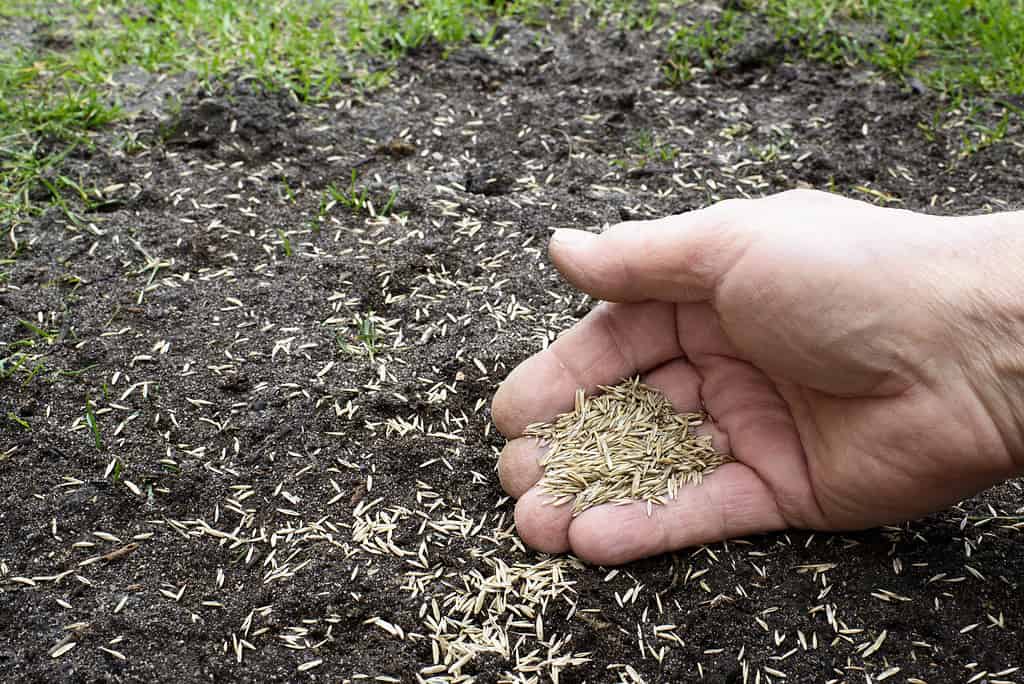
Fall is the best season to sow grass seed or to overseed an existing lawn.
©iStock.com/
The best time to sow grass seed is early to mid-fall. This applies both to new yards and overseeding existing yards. Sowing in the fall allows the grass seed to germinate (which takes 10-20 days) and for the root system to develop before winter dormancy.
Spring seeding can also work, but the roots may not be prepared to deal with the hot, dry summer that is coming. You will need to stick to a strict watering schedule to keep that grass growing.
Summer seeding is easily the worst option due to the hot, dry weather.
Summary of When the Best Time to Water Your Lawn Is
Here’s a recap of the tips and tricks we gave to help you keep your lawn healthy:
| Number | Question | Answer |
|---|---|---|
| 1 | When Is the Best Time to Water? | 6 a.m. to 10 a.m. |
| 2 | How Do I Know If My Lawn Needs Water? | Water if your grass is discolored, a dull green or gray, has curved blades, or footprints don’t disappear quickly. |
| 3 | How Much Water Does My Lawn Need? | 1-1.5 inches each week, divided into two watering sessions separated by several days |
| 4 | How Often Should I Water My Lawn? | Never cut more than one-third of a grass blade when you mow, as this can lead to brown spots. In summer, raise your mower deck to at least three inches to provide extra shade for the roots. |
| 5 | Should I Water More in Hot Weather? | Add one more day to your weekly watering schedule during a heat wave. When 85°F or above, hit your lawn with a quick burst of water in the middle of the day to cool off the grass. |
| 6 | When Should I Stop Watering for the Year? | Many people stop watering too early each year. Keep watering your lawn until the ground freezes. |
| 7 | How Short Should I Mow My Grass? | Never cut more than one-third of a grass blade when you mow as this can lead to brown spots. In summer, raise your mower deck to at least three inches to provide extra shade for the roots. |
| 8 | When Should I Sow Grass Seed? | Early to mid-fall |
The photo featured at the top of this post is © iStock.com/MaYcaL
Thank you for reading! Have some feedback for us? Contact the AZ Animals editorial team.







